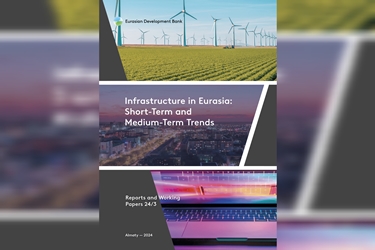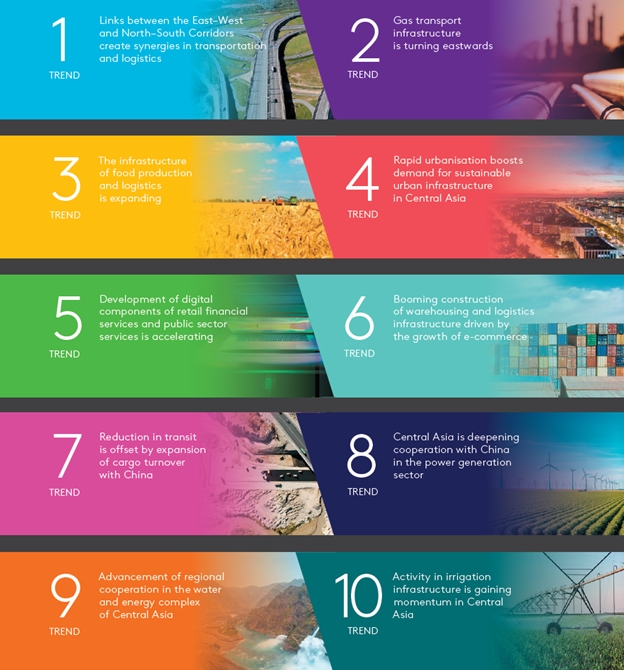 The Eurasian Development Bank’s (EDB) latest report titled Infrastructure in Eurasia: Short-Term and Medium-Term Trends highlights ten significant trends in the region’s energy, transportation, logistics, water supply and telecommunications sectors.
The Eurasian Development Bank’s (EDB) latest report titled Infrastructure in Eurasia: Short-Term and Medium-Term Trends highlights ten significant trends in the region’s energy, transportation, logistics, water supply and telecommunications sectors.Through meticulous monitoring, the EDB has identified ten important short- and medium-term investment and institutional trends affecting Eurasia’s infrastructure. These trends hold practical value and influence the investment decisions of governments and private investors. Many trends are emerging due to changes in the global geopolitical agenda, while others have been evolving over a long period to clearly manifest themselves now. The report primarily focuses on Central Asia, which is experiencing increased attention from major political and economic players.
1. Links between the East–West and North–South corridors create synergies in transportation and logistics. The Eurasian Transport Network is experiencing a phase of rapid development. Eastward and southward freight flows are increasing. The load on the transportation and logistics infrastructure along the Northern and Central Eurasian corridors has surged. The EDB’s optimistic projection for 2028 freight traffic via the International North–South Transport Corridor has materialised earlier than expected, with traffic reaching 19 million tonnes in 2023. Countries in the region have identified priority investment projects and embarked on “big” construction initiatives. There are initiatives to establish new international transport corridors spanning east-west and north-south directions, thereby expanding the scope of the Eurasian Transport Network. The diverse array of linkage combinations presents a wide range of opportunities for freight deliveries among various Eurasian countries.
2. Gas transportation infrastructure is turning eastwards. New gas supply routes are being devised within the region. Cooperation efforts to rehabilitate and expand gas transportation infrastructure have been intensified. Investment projects are underway. In 2023, gas exports via the Power of Siberia pipeline experienced a 1.5-fold increase. LNG exports to China grew by 23% year-on-year, and LNG supplies to Turkey and India also witnessed significant increases. There is ongoing consideration regarding the potential establishment of gas hubs in Turkey and Iran. This shift represents a long-term trend of high importance to all Eurasian countries. It entails the implementation of investment projects aimed at reconstructing and constructing gas pipelines and developing gas distribution networks, gas storage facilities, LNG production facilities and regasification terminals, gas chemical facilities and other necessary infrastructure.
3. The infrastructure of food production and logistics is expanding. Eurasia continues to witness positive developments in agriculture, maintaining one of the world’s highest agribusiness development potentials. Since early 2018, Russia and Kazakhstan have seen their agribusiness exports double, reaching US $45 billion and US $6 billion, respectively. Further unlocking this existing potential holds the promise of significantly enhancing the sector’s role in promoting global food security, with projections indicating its capacity to provide food for 600 million people by 2035. Eurasian countries possess substantial potential for food exports to foreign markets. To realise this potential, the construction and modernisation of transport and logistics infrastructure facilities will grow significantly in the near future, alongside accelerated development of new supply routes.
4. Rapid urbanisation boosts demand for sustainable urban infrastructure in Central Asia. The modernisation and construction of urban infrastructure in the region pose a structural challenge, comparable in importance to efficient water and energy management. Central Asian countries are experiencing notable urbanisation rates, with their urban populations growing by 9–16% since 2018. This urban growth will stimulate the establishment of state-of-the-art housing and utilities that cater to the needs of households and businesses, while also aiming to optimise the use of available resources. Projections suggest that the number of urban residents will further increase by 15% to reach 45 million by 2035. Urbanisation will shape new requirements for the development of infrastructure in cities and urban agglomerations.
5. Development of digital components of retail financial services and public sector services is accelerating. The active advancement of mobile and fibre-optic communications, coupled with improved Internet accessibility, has contributed to the rapid digitalisation observed across the region. Broadband Internet coverage stands at 80% to 90% in most countries within the region. Digital transformation is expected to further evolve, encompassing the development of digital ecosystems, platforms, new applications and cross-border digital services. Along with the development of traditional digital sectors such as public services, social security and online banking, virtually all sectors are experiencing a profound digital transformation.
6. Booming construction of warehousing and logistics infrastructure driven by the growth of e-commerce. E-commerce in Eurasia is experiencing explosive growth, with an average annual rate of 25% and increased penetration in the underdeveloped territories and market segments. Having secured dominant positions in the domestic markets, large companies are now aiming to scale their logistics advancements to neighbouring countries. Projections indicate that by 2028, online commerce in the region will grow at a rate of 12% annually, reaching a total of 91.4 million users. This strong expansion is poised to catalyse a substantial increase in multifunctional transshipment, consolidation, processing and storage hubs, along with significant enhancements in the logistics sector as a whole. Consequently, the region anticipates a surge in the construction of sorting and storage facilities for consumer goods, particularly high-end warehouses, as well as accelerated development in the logistics industry.
7. Reduction in transit is offset by expansion of cargo turnover with China. During the first ten months of 2023, Eurasia’s foreign trade with China surged by 16% year-on-year, reaching US $277 billion. This rapid growth in the region’s trade with China necessitates the modernisation and construction of transport and logistics infrastructure. Key areas requiring investment include routes linking China with the EAEU and Europe (Northern and Central Eurasian Corridors), China and Turkey (Trans-Caspian International Transport Route), new routes and border crossings from Russia to China (Eastern Polygon), as well as other initiatives to enhance latitudinal connectivity.
8. Central Asia is deepening cooperation with China in the power generation sector. China has been strengthening ties with Central Asian nations, outlining its key priorities in the Xi’an Declaration. China aims to secure access to inland energy resources (oil, gas and coal), uranium and renewable energy sources, while promoting economic development in its northwestern provinces. Central Asia accounts for 80% of trade with the Xinjiang Uygur Autonomous Region. In reciprocation, Central Asian countries are seeking external investment to develop their oil and gas resources. Additionally, they are focusing on expanding energy generation at combined heat and power, hydropower, renewable energy and nuclear energy plants and modernising and constructing power transmission lines, including those crossing borders. The EDB estimates, based on its Monitoring of Mutual Investments, that energy initiatives constitute 52% of China’s cumulative FDI in Central Asia.
9. Advancement of regional cooperation in the water and energy complex of Central Asia. Central Asian countries are ramping up efforts to bolster regional cooperation in the water and energy complex, which has historically functioned as a single interconnected system. The efforts of national governments and international financial organisations are driving this momentum forward. The high energy and water intensity of the region’s industries and agriculture necessitates a fundamentally new level of cooperation. By 2040, pressure on the region’s water resources could nearly triple.
10. Activity in irrigation infrastructure is gaining momentum in Central Asia. Irrigation infrastructure in Central Asia is drawing increasing attention from both public and international investors. Water resources play a pivotal role in the region’s agriculture, with irrigation accounting for up to 90% of water consumption. Central Asian governments plan to implement urgent measures to stimulate investment in the development of irrigation systems in the region and enhance their efficiency. For instance, Kazakhstan aims to halve water losses during transportation and Uzbekistan intends to modernise 80% of its pumps.
The full text of Infrastructure in Eurasia: Short-Term and Medium-Term Trends is available on the Bank’s website.
///Eurasian Development Bank, 20 March 2024
